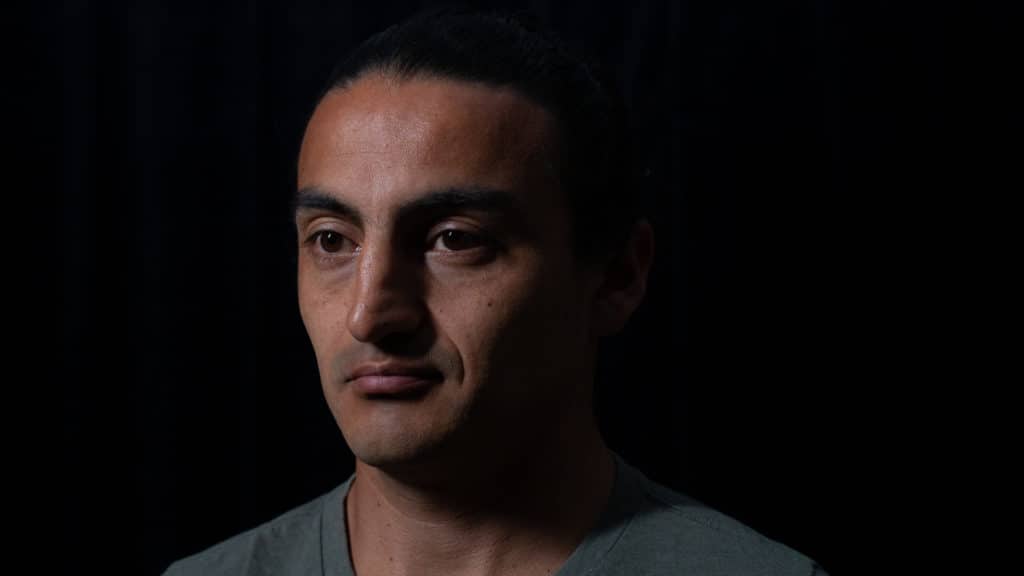Lighting for Filmmaking is the Art of Shaping Shadows
BY COLETTE NICHOL, STORY STRATEGIST & SOLO FILMMAKER
Estimated reading time: 13 minutes


Take a look at the photos above.
It’s the same light. The same direction. The same face. Of course, there’s a difference in how the subject’s head is held. But that’s not the big difference…it’s WHERE the shadows occur on the subject’s face. OKAY, hold that thought. At the end of this post, I’ll tell you what you’re looking at and why it matters.
Lighting for filmmaking is something I struggled with a lot when I first started out as a solo filmmaker.
But rather than completely avoiding this area of weakness, I decided to tackle it head-on.
Because the key to getting good at anything is the focus. I’ve seen that with my students, and I’ve seen it in myself.
So as soon as I realized that cinematic lighting was a weakness, I decided to focus on getting better at it. My filmmaking strengths were a story, connection, framing, and the fact that I freaking love editing and working with computers.
But lighting really messed with my head.
- Where do I put the lights?
- What kind of lights should I use?
- How the hell do I remove that horrible nose shadow from my subject’s face?
- Aaaaah!!! Ad nauseam….
So I started reading and watching whatever I could get my hands on about film lighting types and lighting in general.
And I started practicing.
And I got better and better at the basics of film lighting until eventually I no longer felt like crawling into a hole when I got on the phone with the gear rental house.
Designing lighting is now an enjoyable process where I get to be creative instead of stressed and worried. The neat thing about creating a course (FYI, I’m creating a lighting course right now) is that you go back and revisit everything you’ve ever learned.
What I’ve realized is how HUGE a difference you can make in your visual storytelling with just the most fundamental elements of lighting.
And it’s the fundamentals that we all need to focus on when working to get good at lighting for film and video.
Film lighting can seem intimidating and complex because the gear you see on a big film set is not something a solo filmmaker or small crew will be able to pull off. Plus, the more pro you go, the more complex everything becomes.
But if you’re just starting out, you should know that the most fundamental elements of lighting are not complex.
They’re simple.
And you can just keep getting better and better and better at putting those fundamentals to use.
As you do, your ability to bring to life your vision and make it an on-screen reality grows.
At its core, becoming “good” at lighting is all about training your mind and your eyes to SEE.
You need to really see the world and how shadow and light shape that world and shape your emotions. It’s no longer enough to look at the world, you must begin training your brain to see the world of shadow and light.
I actually think brain training is the most critical part of all learning. But in lighting, it’s particularly true.
So here’s a simple exercise you can do to train your brain and become better at cinematic lighting…
BRAIN TRAINING FOR BETTER CINEMATIC LIGHTING
Take a look around a space, and just look for all the shadows.
Sounds weird? I know. But try it. No really, give it a try.
FIRST
Look at a corner in the room, and find all the shadows.
SECOND
Then let your eye follow the shadows to find the edges and patches of light.
THIRD
Then look to see what the source of light is, and how it’s creating those shadows. What is the angle of the light?
See if you notice any shadows that are beautiful or unusual that you like. Or any shadows that are ugly or distracting that you wouldn’t want in a frame.
FOURTH – BONUS POINTS IF YOU DO THIS!
Grab your cell phone and take some pictures of interesting shadows and lighting patterns in your space. Then examine the images. Would a lighting pattern like that work in a film? If so, what story does it tell?
If not, then why wouldn’t it work?
Why is this exercise powerful?
Because, if you actually do it, you’re practicing focus. You’re focusing your eyes and your brain on what matters most when creating cinematic lighting that tells a story. You’re focusing on shadow and light. Many people think that lighting is all about LIGHT.
Actually, lighting is all about focusing on and shaping the shadows.
That’s why this exercise can be so enlightening. (Erm, pun intended.) You need to train your brain to see the light and the shadows.
Both. Not just one or the other.
Want to learn more about how to tell stories with simple cinematic lighting techniques?
Get on the Wait List for the Cinematic Lighting Course >
WHEN LIGHTING FOR FILMMAKING IT’S ESSENTIAL THAT YOU ANALYZE THE SHADOWS

In the left image, the shadows crawl across the far side of the face. The near side of the face (closest to the camera) is bathed in light. This makes the face look broader. Do you see how the head and face look larger? There’s LESS shading. And the image feels flatter. This is known as using a Near Side Key. What matters is that you see how the shadows are not being used to shape the face in this image.

Over here on the right side, the shadows carve up the face. The light is relatively hard so the shadow is aggressive. But it shapes the face making it thinner, more angular and more assertive. This is a more dramatic look and for many faces, it’s also a more complimentary look. If you used a softer light you could soften up the shape of the shadow but still have this feeling of dimensionality. This is known as using a Far Side Key i.e. the main light is shining into the side of the face that is FURTHEST from the camera.
CLICK HERE to Get the 5 Film Lighting Set-Ups Guide for Free
Learn Filmmaking and Get the Gear Guide
If you’re interested in learning filmmaking, check out the Solo Filmmaking Mentorship Program I created for aspiring filmmakers and video creators. It usually goes live once per year. So I recommend getting the Story Envelope Filmmaking letter which comes out a couple of times per month. That way, you can get filmmaking tips for free and find out when the filmmaking course is going live again.
Also, before you go, grab the Solo Filmmaking Gear Guide and Checklist for Beginners.

About the Author
Hi! I’m Colette Nichol. I’m a solo filmmaker and story strategist based out of rainy Vancouver, Canada. I’ve been making videos and micro films for small businesses and global brands since 2014.
Plus, I LOVE to help aspiring filmmakers pursue their dreams and start making films. This blog is designed to help you gain the knowledge you need to become a filmmaker.
If you want more, get on the waitlist for the Story Envelope Academy Solo Filmmaking Mentorship Program. It opens up one time per year and is the best way to become a filmmaking or video pro fast!
CLICK HERE to get on the solo filmmaking mentorship waitlist.